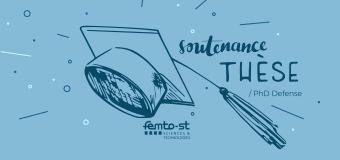You are here

Chibundo NWAFOR : "Contribution to the Miniaturization of Continuum Robots by Using Glass"
Wednesday 15 November 2023 - 1.00 P.M.Abstract : Continuum robots are gaining increasing interest in medical applications, due to their slender shape and compliant nature which makes them safer for human-to-robot interaction. In addition, they are able to follow a 3D complex path, thanks to their infinite degrees of freedom. The goal of this thesis is to take advantage of glass flexibility at the microscale to actualize novel and more miniature continuum robots when compared to those in the literature. The first contribution is a conceptual study, addressing the design and fabrication of different CTR prototypes and deriving a general classification approach while proposing to the research community a concise methodology for the evaluation of CTR in the future. Secondly, we proposed a new generation of a miniaturized sub-millimeter CTR that is made of glass, which has a tube with an external diameter down to 90μm and a 5mm radius of curvature. Furthermore, we presented a novel, easy, and rapid patient- specific/customizable approach to obtaining a pre-curved tube using glass, which was characterized, followed by the robot model validation (forward kinematic, inverse kinematics, and stability analysis). Various demonstrations of proofs-of-concept for the different application capabilities e.g. vitreoretinal deployment in a fish eye, constraint deployment through 3-stationed needles (∼1mm orifice), pre- curved helical and fiber optics CTR deployment with laser transmission capability, and then, fluid suction and delivery. The third contribution was the investigation and demonstration of a miniaturized 3-DoF PCR using glass optical fiber. The robot design has a dimension of 2.5 × 2.5 × 6mm and can reach +90 to −80 degrees in the tip and tilt angle. The robot’s performance such as the workspace, manipulability, and stiffness was evaluated as a function of variations of different geometrical parameters of the robot. For the model validation, different path movements were presented such as vertical plane circumradius and workspace followed by the circular and square shapes in the horizontal plane, which shows the great prospect of the robot for increasing dexterity in confined space. Finally, for both cases, the robot design analysis was very important for investigating the robot stability, for CTR due to torsion, and for PCR, due to the actuation length.
Jury Composition :
Guillaume LAURENT, Associate Professor, Université Bourgogne Franche-Comté, PhD Director
Kanty RABENOROSOA, Maître de conférences, Université Bourgogne Franche-Comté, PhD Co-director
Florent NAGEOTTE, Maître de conférences, Université de Strasbourg, Reporter
Pierre LAMBERT, Professeur, Université Libre de Bruxelles, Reporter
Christos BERGELES, Professor, King's College London, Reviewer
Christine PRELLE, Professeur, Université de Technologie de Compiègne, Reviewer
Localization : SUPMICROTECH ENSMM 26, rue de l'Epitaphe 25000 BESANCON - salle Amphithéâtre Jules Haag









